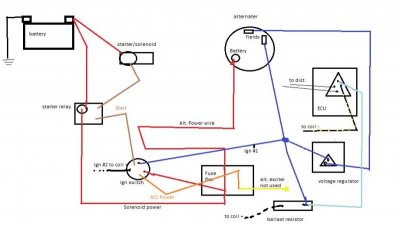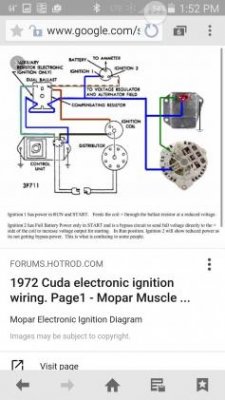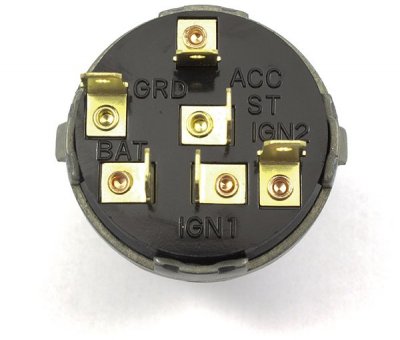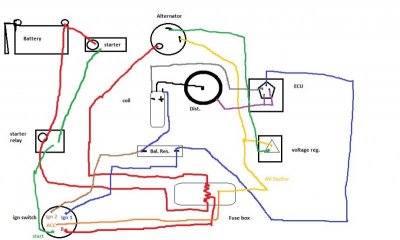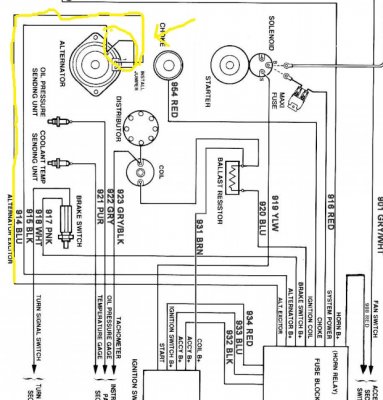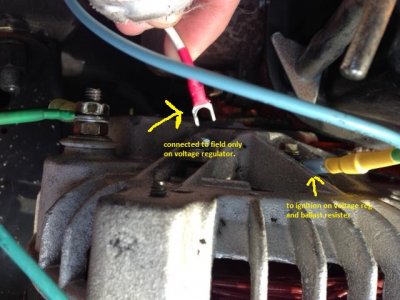RoadWarrior
Well-Known Member
well, After installing my "universal" harness, I have everything working except in "run" position. Not trying to crank yet.
Now, I've wired everything up according to wire diagram. Problem is different sources say different things. I've been around about 20 different boards and I get different answers. Here's what I got.
From Alternator Battery post I have wire going to fuse box, then from fuse box going to Battery post on starter relay. This feeds things that need constant power like hazards, ignition switch power. I have another wire from Battery post on starter relay to battery. Then from Battery to starter Battery post. First lets verify this is correct because:
I've had people say run another wire from Battery post of alternator to battery post on starter relay. Others have said run from alternator to starter battery post, or straight to battery. 3 different options, all involve 2 wires at battery post of alternator. Usually associated with high output alternators which I dont have. I've always had one wire from alternator to inside feeding accessories with constant voltage then out to starter relay like the stock diagram shows. Is this different due to new harness? more efficient? Thoughts?
my main proof of an issue: hot wires. now with ign 1 feed wire unplugged from ign switch, I have constant 12 volts from battery at fuse box. I have 12 volts coming from ign 1 on switch. But when I connect my ign 1 wire to ign switch then this happens: In run position "feeds voltage from Ign 1 to ballast/ acc feeds 12 volts to fuse box" the voltage from battery/ alternator drop to 6 at fuse box. Acc wire gets hot. This tells me the problem is ballast resistor, voltage regulator, or alternator. I removed ign 1 wire from ballast resistor but nothing. same problem. So maybe voltage regulator?
ign1 splices to ign on voltage regulator, field on alternator, and ballast resistor. I should mention I have electronic ignition so the ecu blue/yellow also splices in to all this. voltage regulator is new, and grounded. Ecu is grounded.
My car started having issues in "run" position before new harness install. So maybe my ecu went bad?
Alt exciter wire from fuse box is not used, but I will mention all new harness diagrams show it replacing ignition one to voltage regulator. meaning ign 1 and ecu are the only wires connecting to ballast resistor. But i've tried both ways and have the same problem.
I think my ignition switch is fine because like I said, as long as my ign 1 feed to ballast resister is removed, acc wire doesnt get hot, I have 12 volts at fuse box, and my lights and everything work.
I am guessing either my ecu went bad finally, or I bought a defective voltage regulator. my third guess is ignition switch, but doubtful.
any suggestions would be great. how to test ecu, regulator, etc. I feel like I am missing something simple since I've wired it correct to mopar diagram with ecu. only difference in this case is a universal harness instead of factory correct.
Now, I've wired everything up according to wire diagram. Problem is different sources say different things. I've been around about 20 different boards and I get different answers. Here's what I got.
From Alternator Battery post I have wire going to fuse box, then from fuse box going to Battery post on starter relay. This feeds things that need constant power like hazards, ignition switch power. I have another wire from Battery post on starter relay to battery. Then from Battery to starter Battery post. First lets verify this is correct because:
I've had people say run another wire from Battery post of alternator to battery post on starter relay. Others have said run from alternator to starter battery post, or straight to battery. 3 different options, all involve 2 wires at battery post of alternator. Usually associated with high output alternators which I dont have. I've always had one wire from alternator to inside feeding accessories with constant voltage then out to starter relay like the stock diagram shows. Is this different due to new harness? more efficient? Thoughts?
my main proof of an issue: hot wires. now with ign 1 feed wire unplugged from ign switch, I have constant 12 volts from battery at fuse box. I have 12 volts coming from ign 1 on switch. But when I connect my ign 1 wire to ign switch then this happens: In run position "feeds voltage from Ign 1 to ballast/ acc feeds 12 volts to fuse box" the voltage from battery/ alternator drop to 6 at fuse box. Acc wire gets hot. This tells me the problem is ballast resistor, voltage regulator, or alternator. I removed ign 1 wire from ballast resistor but nothing. same problem. So maybe voltage regulator?
ign1 splices to ign on voltage regulator, field on alternator, and ballast resistor. I should mention I have electronic ignition so the ecu blue/yellow also splices in to all this. voltage regulator is new, and grounded. Ecu is grounded.
My car started having issues in "run" position before new harness install. So maybe my ecu went bad?
Alt exciter wire from fuse box is not used, but I will mention all new harness diagrams show it replacing ignition one to voltage regulator. meaning ign 1 and ecu are the only wires connecting to ballast resistor. But i've tried both ways and have the same problem.
I think my ignition switch is fine because like I said, as long as my ign 1 feed to ballast resister is removed, acc wire doesnt get hot, I have 12 volts at fuse box, and my lights and everything work.
I am guessing either my ecu went bad finally, or I bought a defective voltage regulator. my third guess is ignition switch, but doubtful.
any suggestions would be great. how to test ecu, regulator, etc. I feel like I am missing something simple since I've wired it correct to mopar diagram with ecu. only difference in this case is a universal harness instead of factory correct.

